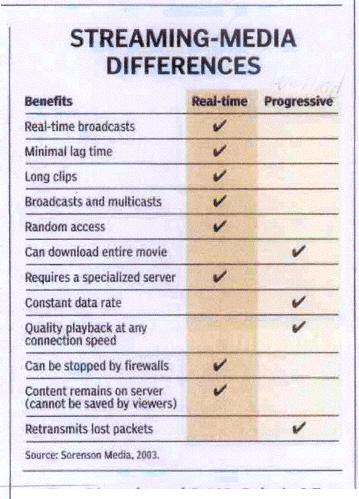Streaming Protocols 10
Streaming Types
Both Ernst (2003) and Wilson (2007) draw the distinctions between server types and file types and related protocols that make streaming a reality. Fundamentally, Ernst as well as Mack (2002) recognizes real-time streaming as media that is sent and never touches the user’s hard drive. The distinction they are drawing is that a file that can be downloaded is not a real-time file.
This distinction is further explained by Ernst (2003) noting there are two types of streaming methods: progressive and real-time. Real time works with a streaming server package that needs to be matched with a compatible streaming client that has the requisite protocols. The progressive streams are described as “regular files.”
Progressive streams are sent to users via conventional Web servers such as Apache and Microsoft IIS. In fact, progressive streams are just “regular files”—such as MP3, QuickTime(MOV), RealMedia(RM), and MPEG video—which are designed to stream naturally, Such files can stream content because various media players, including QuickTime, RealOne Player, Winamp, and Windows Media Player can start playing these files as they are being downloaded. (Ernst, 2003, p. 76)
Thus, the players use protocols that allow the streaming of content. Figure 3: Streaming-Media Differences further illustrates the distinction between the two streaming methods.
Streaming Protocols 11
Figure 3: Streaming Media Differences

(Ernst, 2003, p. 76)
Accordingly, both the
server’s transfer and the client’s system break files into very small
pieces and send them to a specific location in a specific order. As the real-time protocols are steaming
the files, other traditional Web protocols are still working in the background
(
Bandwidth and Encoding
What can be streamed over the internet is dependent on two factors: bandwidth and encoding.
Bandwidth is the technical factor which plays the largest role in the development of streaming media distribution. The user has to deal with this keyword at every level of the production and delivery process of streaming media. Bandwidth describes how much information can be transferred in defined time over an information channel. It is measure in bits per second (e.g. Kbps or Mbps). (Künkel, 2003. p. 4)
Streaming Protocols 12
Before anyone can watch or listen to streaming media, raw audio and video files must be converted to a format that can be streamed across the Internet. This is done using a streaming media encoder, and is known as encoding. (Mack, 2002, p.34)
Codecs are used both for the encoding and decoding of streaming file type. The codec unpacks the data for a media player. Since raw streaming files are too large and may require too much bandwidth they are compressed through the encoding process before they are sent over the Internet (Mack, 2002).
Conclusions
There
are certain advantages for using specific protocols for streaming that
incorporate the appropriate encoding technique However, there are competing protocols
on the market that inhibit interoperability. Little or no interoperability exist
between the three major streaming platforms. “Both Apple QuickTime and RealSystem use (Real Time Streaming Protocol, while
Microsoft uses its own proprietary protocol known as MMS (Microsoft Media
Services) (Mack, 2002, p. 36).”
Thus, for two computers on different platforms they must use the same
protocols to communicate (Steinmetz & Nahrstedt.
2004). Finally, a table is prepared
that summarizes five protocols based on the works of Ernst (2003), Künkel (2003), Mack (2002), and
Return to Web Site's Index
DELAWARE'S MIDDLETOWN ODESSA AND TOWNSEND AREA
